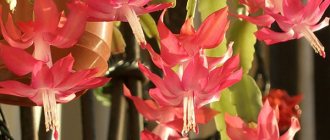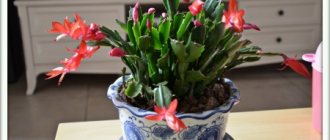Not so long ago, the Decembrist could be found in almost every home. I fell in love with it for its ease of care and abundant and bright flowering in winter. Decembrist is the popular name given to the plant for the time of year when it blooms. And the botanical name is Schlumbergera zygocactus (Schlumsergera). In this article we will talk about the features of caring for the Decembrist flower at home.
Description of the plant 2. Growing a succulent 2.1. Planting and transplanting 2.2. Recommendations for care during various periods 2.3. Trimming 2.4. Succulent propagation 2.5. Diseases and pests
Photo by O. Nikonorova: The plant is quite unpretentious in care.
In the literature on floriculture, this plant is often called zygocactus. There are other names by which it is called in everyday life: Christmas tree, crab cactus, Decembrina, Varvarin color. Varvarin - because it blooms by mid-December, on St. Barbara’s Day.
Do not overfill
It is necessary to avoid too much watering, as the plant does not like it and it will not bloom. If the Decembrist began to shed leaves, it means that it was overwatered. In this case, you can get by with simply spraying the soil and crown, which should be done once every 1.5-2 weeks. After flowering, a rest with limited watering will be required as it will produce buds again much faster this way.
Recommendations for growing home Decembrist flower at home
Zygocactus is not capricious. A suitable place for it would be a bright window sill on the east or north side. The place should be a little cool, without getting too hot in winter. In spring and summer, it is advisable to take the pot out onto the loggia or balcony, and best of all, onto the porch or outside. In the fresh air, the plant will grow more actively, harden and become stronger.
When selecting soil, we always look at the origin of the plant, where and how it grows. Decembrist grows on the bark of trees, so the soil must be very loose, airy and moisture-permeable. You can use commercial substrate for cacti or succulents. Add a little charcoal to it if it is not included.
You can make the soil yourself: take equal parts of leaf soil and washed, sifted river sand. Add some charcoal and peat.
Decembrist planting and replanting
A young bush is replanted once every 2-3 years, in the spring - from March to May. Mature bushes are transplanted every 4–6 years at the same time. When the Decembrist blooms, it is better not to disturb it. But if there is an urgent need, then you can carefully transfer it without disturbing the earthen lump.
- When replanting, take a new pot slightly larger in diameter than the previous one (2–4 cm). You should not take a high pot: the plant has a superficial root system that will not grow in depth. There must be drainage holes at the bottom of the pot.
- A small layer of drainage (2–3 cm) is poured onto the bottom. For drainage, you can use expanded clay, polystyrene foam, broken brick, and small pebbles.
- We fill in the substrate, not reaching the top edge 2–3 cm.
- We plant the plant without deepening it. Plant at the same level that the plant grew before.
- We lightly compact the soil around the bush with our hands and water it with settled water.
Photo: It is important to choose the correct size of the pot.
Caring for the Decembrist flower at different times of the year
Plant care will vary throughout the year. Conventionally, it can be divided into periods:
- Vegetation of the plant. Lasts from March to September.
- Dormant period (preparation for flowering). It's October.
- Flowering lasts from November to January.
- Dormant period (after flowering). From February to March.
You need to know these points and provide the necessary care during each period. Below we will look at each period in more detail.
Care during the growing season - from mid-March to September
At this time, the plant is actively growing shoots. It is best to take the Decembrist outside and place it in openwork shade from bushes or trees. It is ideal to place the pot on a covered porch or gazebo to prevent rain from flooding the plant.
We do not allow overflow. Decembrist quickly rots with excess moisture. You can take it out onto the balcony with open windows. Water the indoor plant moderately; it responds very well to spraying from a spray bottle. You need to water and spray either early in the morning or in the evening, when there is no scorching sun.
| Important. Water for irrigation should be warm and settled. Rainwater, pond water or aquarium water are best. |
Since the plant is actively growing, it needs good nutrition. We feed every 10–14 days with universal flower fertilizers. Comfortable temperature for good growth is from +20 to +25 degrees.
Photo by O. Nikonorova: Water the succulent with warm and settled water.
Care during the first dormant period - from October to November
The plant begins to prepare for the upcoming flowering period. It seems to freeze and stop growing. But this is only at first glance. The plant is actively laying flower buds and gaining strength for flowering. This moment is very important not only for the flower, but also for the grower. After all, whether the plant will bloom this year or not depends on the correctness of his actions.
- We reduce the number of waterings. Lighting will naturally be reduced a little, but this is necessary for the plant.
- A little coolness and an influx of fresh air (but not a draft) are useful at this moment.
- Optimum temperature +10…+19 degrees.
- If a flower pot has been outside all summer, then do not rush to bring it home. Let it sit outside until frost, until the end of October. Cooler weather will encourage more flower buds to set. The Decembrist is able to withstand temperatures dropping to +5 degrees.
- We reduce watering, only occasionally water and spray the foliage. We don’t overdo it and don’t let the foliage dry out. Then they will lose turgor, become soft and shrunken. The leaves throughout this period should be elastic, dense and juicy, green in color.
| This is interesting! It has long been noticed that after watering with tea, the Decembrist blooms profusely. Even specimens that have never bloomed bloom. This fertilizer is considered better than any expensive purchased fertilizer! |
- In October you need to feed the plant with complex flower fertilizer. It will also contribute to rapid flowering.
Caring for Decembrist during the flowering period - from early November to January
In the second half of October–early November, we bring the plant indoors from the street. If the Decembrist was at home all the time, then there is no need to do anything.
- We increase the frequency of watering. You can alternate watering with warm water and warm tea.
- Every 10–12 days we feed with phosphorus-potassium fertilizers or any for flowering plants.
- To make the buds large and strong, we feed them with calcium nitrate or an infusion of eggshells.
| Note. Recipe for an infusion of eggshells: wash the raw shells thoroughly under running water, knead them with your hands and put them in a jar. Fill with warm water and leave for 1 day. Next, add it little by little to the water for irrigation. |
- The optimal room temperature for the full formation of buds is +18...+23 degrees during the day and +16...+21 degrees at night.
- During flowering, we try not to move the pot to a new place, and not to turn it towards the light again. The ideal option is not to touch the Decembrist.
Photo: It is better not to move the plant during flowering.
Caring for Decembrist during the dormant period after flowering - from February to March
Water moderately after the soil in the pot dries. To prevent the plant from growing one-sided, we periodically turn it towards the light.
Care after flowering
In February, a period of rest begins for the Decembrist. At this time, the flower is watered less, after the top layer of soil has dried, but without allowing the coma to dry out completely. Also in February, the bush is formed by twisting out the segments at the ends of the shoots. This procedure helps the plant develop lateral shoots and the bush becomes denser.
After flowering, the plant is given the desired shape and left to rest, occasionally watering
The unscrewed apical shoots can later be rooted and a new plant can be obtained.
Forest cactus segments take root well
Plant diseases and pests
The main diseases of the Decembrist are provoked by increased soil moisture.
These include:
- fusarium;
- root rot;
- late blight
It is best to use systemic drugs for treatment (Fundazol, Skor), which, penetrating through the roots of the plant, spread to all its tissues. The infected plant should be kept separate from healthy plants. If necessary, it is better to replace the soil and disinfect the container.
In case of pest infestation (mealybug or spider mite), you need to use insecticidal preparations (Aktara, Fitoverm). When fighting mealybugs, plant segments are washed with a light soap solution.
Decembrist flower propagation
It propagates quite easily - by small cuttings taken from the plant. It is enough to plant 1-2 leaf segments. It is better if there are several segments at once (up to five). Rooting occurs faster in the spring and summer.
- Using unscrewing movements with your hands, remove the cuttings from the bush. They break off easily and therefore no scissors or pruning shears are required. And the wounds on the plant heal faster in this case.
- Dry the resulting cutting in air for a day or overnight. We put it in a place where the sun's rays do not reach. The soil for planting must be loose. A store-bought cactus mixture will do.
- It is good to root the cuttings in a transparent plastic cup. Through the transparent walls, the roots are immediately visible and it is easy to control the cutting if it is rotten or the soil is too dry. Be sure to make drainage holes at the bottom of the cup.
- We bury the cutting into the ground to one-fourth the height of the segment.
- We water it from a spray bottle and place the glass in a bright and warm place where the cuttings will not be exposed to direct sunlight. You can make a greenhouse by placing the cuttings in a plastic bag with holes, or cover it with another glass on top. But I can tell you from experience: it takes root well and quickly even without a greenhouse.
| Advice. To speed up the process, you can dip the tip in Kornevin before planting. |
Diseases and pests of the home flower Decembrist
The disease occurs when the plant is not properly cared for. Decembrist can be affected by late blight, fusarium and other bacteria.
Pests also sometimes attack it: scale insects, mealybugs, spider mites. With good care, he does not cause any trouble and rarely gets sick.
Photo: Follow the propagation guidelines to get beautiful flowers. ______________________________________________________________________________________________ Read our other articles about indoor plants: Lunar calendar for indoor flowers for 2022
Planting and caring for arrowroot: how to grow a delicate flower at home Unpretentious sansevieria: care, planting and propagation at home How to care for shefflera at home: we take care of it correctly ________________________________________________________________________________________________ Do you grow Decembrist? Share your experience and care tips with other gardeners in the comments.
Choosing a cutting
A very old plant should not be used for propagation. Carefully inspect the flower, select a less dense area. Find the place where the young segments end and the old ones begin. The shoot must be healthy, undamaged and consist of at least two leaves. Use a rotating motion to unscrew or break off part of the stem. It's good if it has aerial roots, but don't be upset when there aren't any. In this article we will tell you how to plant a Decembrist shoot without roots.
When separating the cutting, hold the mother plant with your hands. Fill the wound on the flower with sand or charcoal. If you want to grow a lush Decembrist bush, then use several cuttings. Do not use scissors or a knife to obtain them.
Preparation of cuttings
The separated parts of the shoots are laid out on paper or cloth and dried for two to three days in a dark, dry place. Prepare drainage. You can use expanded clay that was previously used for another crop. In this case, it is washed and dried. Carefully read the instructions for drainage: some types require moisture before laying. The drainage is soaked in soft, clean water. It is important to know that the maximum period for using expanded clay is six years.
Prepare a homemade potting mix or store-bought potting mix. Soil prepared independently must be disinfected with boiling water or by placing it in a preheated oven or microwave for ten minutes. Treat the new pot with boiling water and dry it. You can use disposable plastic cups as the first container.
Rooting
Cuttings can also be rooted in water. To do this, you need to place the shoot in a container with settled warm water. This must be done in such a way that only half of it is immersed in water. When evaporating, the liquid must be topped up regularly.
If the water becomes viscous and yellowish over time, it has gone bad. In this case, the cutting must be thoroughly washed and placed in a container with clean water. After a week or two, the first roots appear. After this, you can transfer the Decembrist to the ground. You already know how to plant it. Then it is cared for like an adult plant.
Selection of capacity
We should not forget that the roots of the Decembrist are superficial, moreover, they are very sensitive to various unfavorable conditions. If they are overcooled or overheated, or the soil becomes acidic, they rot and die. For planting you need a low and fairly wide pot. In a very deep container, the roots do not reach the bottom, so moisture can accumulate below. This waterlogs the substrate and causes rot.
When choosing a pot (if you are replanting an adult plant), the size of the new container can be easily determined by placing it in a new old flowerpot. It should enter completely, and there should be a little free space between the walls (no more than a centimeter). Decembrist can be planted in both ceramic and plastic containers.
Landing
So, we have completed all the preparatory work, and it’s time to find out how to plant a Decembrist shoot. In a container one-third filled with drainage, pour soil mixture up to half the height of the pot. Compact the soil a little and water it well. Make a small indentation in the center. If you want to get a lush bush, plant several cuttings, making indentations in accordance with the number of shoots.
The lower tip of the cutting without root is treated with “Zircon” or “Kornevin”. It is planted as if placed on the ground. If the cutting has roots, they should not be deeply buried - the depth should be a maximum of one centimeter.
Instructions for cutting Schlumbergera
An indispensable condition when choosing a cutting for propagation is a healthy mother plant. The shoot must meet several requirements:
- The sheet plate is without scratches, cracks or other mechanical damage.
- Choose a shoot with good turgor.
- If some segments have aerial roots, give preference to them.
How to propagate Schlumbergera by cuttings? Algorithm for preparing cuttings for planting:
- The selected shoot of 2-3 segments is unscrewed from the mother bush. With one hand he turns clockwise, with the other hand he holds the branch.
Further actions depend on the rooting method.
Read about how to plant Decembrist shoots and other methods here, and from this article you will learn whether it is possible to prune Schlumbergera and how to do it at home.
In the ground
To root the cutting you need to prepare:
- Pot or plastic cup up to 200 ml.
- Substrate - special soil for cacti, bought in a store, perlite or a mixture made independently (read about what should be included in the soil for Decembrist and how to prepare it yourself). The soil should be light and loose. For the mixture, leaf and turf soil, peat, and sand are used. The inclusion of perlite and ground sphagnum helps improve soil structure.
- A plastic bag or glass jar for setting up a greenhouse.
A layer of drainage (1/3 of the volume) is poured onto the bottom of the pot, and the substrate is added on top. When rooting in perlite, drainage is not required.- The soil is well moistened.
- The prepared cuttings are buried 5 mm.
Plant 2-3 shoots in a large pot, and one in a cup. To create a stable microclimate and maintain high humidity, the container with the cutting is covered with a jar or bag.
The use of Kornevin, a biological plant stimulant, will help accelerate root growth . Before planting in the ground, it is enough to dip the cut of the cutting into the preparation.
The Decembrist shoot is placed in a warm (18-20°) place with diffused lighting. Every day the greenhouse is opened for ventilation for 30-40 minutes.
Successful rooting is indicated by the emergence of new segments. If growth points are detected, you can remove the shelter. Schlumbergera propagation in substrate takes about a month.
In water
Let's look at how to root Schlumbergera at home. Plastic cups (150-200 ml) or glass jars are used as a container for rooting Decembrist. The water must stand for at least a day to remove chlorine impurities. For rooting in water, it is convenient to use long shoots of Schlumbergera. The liquid level in the glass is one segment. If necessary, add water.
In a transparent container, the appearance of roots is clearly visible. They grow back in 1-2 weeks. During this period, it is necessary to monitor the condition of the water. If it becomes cloudy, replace it immediately. This will avoid rotting of the cuttings.
A few drops of “Kornevin” added to the water will accelerate the formation of roots on the Decembrist cuttings.
Having received roots more than 2 cm long, you can transplant the shoot into a pot. The procedure is similar to that described above.
Requirements for the container: drainage, drain holes, loose, slightly acidic soil. The planted cuttings are watered and left away from light. A week later it is placed on the windowsill. The soil is moistened as it dries. The intensity of watering depends on the temperature and humidity level in the room (read about how to properly water Decembrist so that it blooms luxuriantly and is healthy). The appearance of new segments means that the cactus has taken root.
What is it for?
By cutting off old shoots, you will get a much more abundant flowering plant , since buds appear exclusively on new shoots.
The new stems will be stronger and capable of bearing a large number of flowers. Pruning is also carried out in order to form a beautiful bush. This can be done at your own discretion - some people like symmetry, others want a different shape, it all depends on your imagination. In addition to improving flowering and flower shape, if you prune, the zygocactus will live longer. Some types of plants can bloom for 20 years or longer if plucked in a timely manner and cared for properly.
As Schlumbergera grows, its lower branches will become longer and droop. If you do not want to prune, you can hang the flower on a flowerpot.
Useful video
From the video you will learn how to transplant a rooted Schlumbergera cutting:
If you find an error, please select a piece of text and press Ctrl+Enter.
Decembrist cannot be called an overly demanding plant. However, you should not neglect the rules of caring for it. This also applies to transplantation.
An untimely or incorrectly performed procedure harms Schlumbergera and prevents flowering.
Therefore, it is important not only to know how to transplant Decembrist, but also to choose the most favorable moment for these manipulations. Is it possible to transplant a flowering plant in winter or is it better to choose another time? How to act correctly? We will tell you step by step about the transplant procedure and show you a photo.
What to feed Schlumbergera?
During the replanting process, the following types of fertilizers can be added to the soil mixture for Schlumbergera:
- Humus . Not only is it rich in nutrients, but it also retains these components in the root zone. The humus particles retain their elasticity, due to which there are air gaps between them for the root system to breathe.
- Wood ash . Serves as a natural mineral fertilizer. This fertilizer contains a large amount of potassium and phosphorus.
- Rotted compost . It will significantly increase flowering.
- Bone flour . Rich in phosphorus, which is responsible for root formation and bud formation.
You can find out what to feed Schlumbergera and how to care for it so that the plant blooms here.
When is the transplant performed?
The first zygocactus transplant is carried out after purchase . In the store, the plants are kept in transport soil. Such land is not suitable for further cultivation of Schlumbergera and can lead to its withering. Immediately after the store-bought Schlumbergera has faded, it must be transplanted into a nutrient substrate.
Further transplants are needed to provide the root system with new space, as well as to renew the old soil. The best period for the procedure is spring, after flowering has completed. By this time, the soil in the pot is depleted, and its renewal will be very useful for the faded zygocactus.
Flowering begins in December and lasts for about two months, so Schlumbergera cannot be replanted in winter .
It is also not recommended to perform the procedure in summer and autumn. Transplantation is a lot of stress for a plant. In order for the Decembrist to successfully take root in a new place, a long period of favorable conditions is required.
After the spring transplant, Schlumbergera will have about five to six months left, during which it will receive the required amount of heat and light. This will give the plant enough time to recover before next winter and gain strength to bloom again.
Detailed step-by-step instructions
Planned transplantation is usually carried out using the transshipment method . To do this you need:
Take a clean, dry flowerpot one to two centimeters larger than before.- Prepare fresh disinfected soil.
- Prepare a new clean drain. If expanded clay from other crops is used, it must be washed, disinfected and dried.
- Fill one third of the pot space with a drainage layer. Tap the sides of the flowerpot and shake lightly to ensure even drainage.
- Place a layer of new substrate at least one centimeter high on top. Flatten.
- Spread newspapers on the floor.
- Shallowly loosen the soil around the edges of the flowerpot in which the Decembrist grows.
- Holding the base of the trunk and turning the Schlumbergera onto the floor, carefully remove the plant from the old pot.
- Gently shake off the soil from the roots. You can remove only that part of the soil that comes off without effort.
- If the root system is healthy, place it together with a lump of earth in a new flowerpot.
- Holding the Schlumbergera suspended in the center of the pot, fill the container with fresh substrate. When the roots are completely covered with soil, rotate the pot several times, lightly tapping its side walls so that the soil fills all the voids. It is important to position the plant evenly, without distortion. This will allow the crown to form evenly.
- Lightly compact the soil. Do not compact too much, otherwise the fragile roots may be damaged.
- When the soil settles down after watering, add a little more substrate. There is no need to fill the flowerpot to the brim.
- Place the pot with the plant in a permanent place.
After purchase or in case of rotting of the plant’s root system, the procedure becomes more complicated:
- After removing the Decembrist from the old flowerpot, you need to carefully shake off the particles of the old substrate from the roots.
- Inspect the root system. Remove unhealthy areas with a sterile instrument.
- Rinse the roots with warm water and dry.
- Sprinkle the cuts with crushed coal.
- Next follow the same steps as for a planned transplant.
Watch the video on how to transplant the Decembrist:











